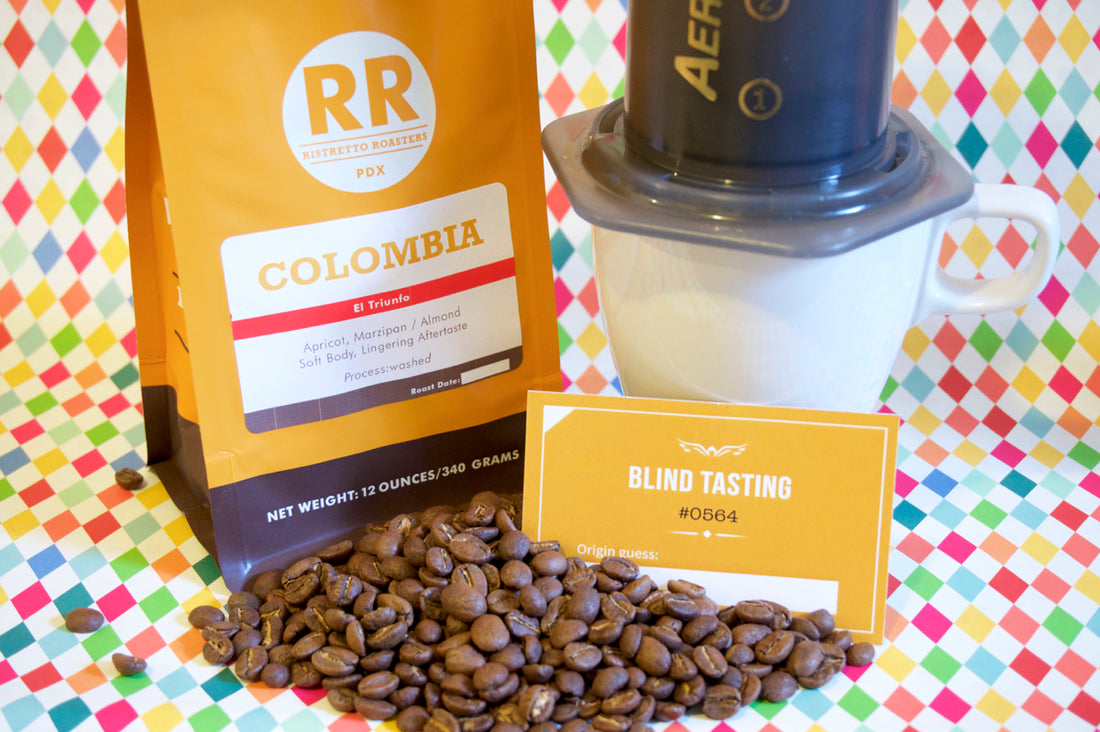
2016 Aeropress Champ and DoE @ Ristretto Roasters: Coffee Talk w/ Ben Jones - Ep. 10
Share
In Ep. 10 we chat with Ben Jones, Director of Education at Ristretto Roasters and 2016 US Aeropress Champion! After getting to know Ben a little bit, we dive right into his Aeropress recipe (see table below). We also get to learn a little bit about what Ben does as the Director of Education at Ristretto Roasters and he shares some tips to help us be better coffee tasters!
Before we dig into the details of Ben's recipe, it's worth checking out Rusty Obra's recipe from Episode 7. It's more traditional and definitely a better starting point if you want to enjoy an Aeropress at home. Ben's recipe is quite advanced! ?
Variable, Setting
Method, Upright (not inverted)
Coffee, 26g
Water, 175g to brew + 75g to dilute
Ratio, 9.6 (!)
Temp, 208 ℉
Filter, Able fine + 2 Aeropress paper filters
Time, 2:00
Insulated with a german beer cozy, Ben uses water "as hot as he can get it". In the case of the comp, that was 208 ℉. This is the first big departure from the norm, with many Aeropress brewers preferring cool water (in the 185 ℉ range).
The second thing that really makes Ben's recipe stand out is the filter strategy. I think there was an incorrect report that he used a paper-metal-paper sandwich. He actually used a paper-paper-metal arrangement, with the paper facing the coffee. This allows Ben to filter out more of the sediment and oils without creating too much back pressure and risking a "blowout". Might sound crazy, but this happens on a regular basis. :/
And finally, Ben's aeropress recipe is crazy strong! He mentions in the interview that this is NOT what they use at Ristretto for customers. But the judges seem to have a preference for stronger cups. I've also noticed that I tend to enjoy stronger coffee, but I'm hesitant to lower my water:coffee ratio too much. Ben's comments have given me some encouragement to further experiment with very strong coffee. I also noticed that Blue Bottle's batch is crazy strong. I once brought home a sample and ran it through a refractometer. It was about 50% stronger than what I usually brew (though still enjoyable). Rising coffee strengths could be a trend I get behind.



The Ben Jones 2016 US Aeropress Recipe:
Key Interview Highlights
The general rule: if you use hot water, you're going to get more acidity. If you use cool water it's going to be a little more mellow of a cup of coffee. You get a little more body when you use hot water. You get a little faster extraction when you use hot water. Needs a little more exposure time if you drop the temperature. The Colombia Triunfo that you guys I believe have from us (*NOTE - this was shipped in both our tasting flights and All Stars) is really dynamic. If you hit it with really hot water you get floral aromas and a lot of white sugar honey flavor. If you use cooler water the sugar expresses as more of a brown sugar, almost molasses or BBQ sauce flavor. Aeropress doesn't hold heat very well. The challenge has always been that the water cools off so quickly especially if I want to do a long brew time. I don't usually go for super acidity coffee. Ristretto Roasters is a fully developed, second crack roaster. We go for coffees that taste like coffee, not so much unsweetened lemonade. But with the Aeropress I find I really like what I was getting with hotter water. I find I get peanut flavors when I use cooler water. We have this tendency to try something one time and say "that was gross, I'm never going to do that again". You get better at doing things by doing them over and over again. If you do something the first time and it's gross, that's not necessarily the brew device's fault. There are very few manual brew methods that are bad. You just have to learn how to work with them. This was the 75th anniversary of the Chemex, but it's also the 75th anniversary of Juan Valdez. He was invented 75 years ago when Colombia set out to create a very uniform profile for national coffee branding. So the the American palate, Colombian coffee specifically Folders coffee is the definition of coffee flavor. So maybe that's why I like Colombian coffee so much, tastes like coffee! Can I make a confession? I'm going to come out of my coffee closet a little bit here. One of the things I love about flying is I get to drink really bad coffee. It keeps me calibrated. The World Coffee Research Organization put out the Tasting Lexicon, and in there's 110 different reference points for what all the different flavors are. I highly recommend visiting their website, it's a free download of 50 pages. When we say "this coffee tastes winey", they have a reference point for that it's Yellow Tail Cabernet Sauvignon. It might not be the most elite representation of those flavors, but it's that common reference point.

